
Trilobites are extinct marine arthropods that form the class Trilobita. Trilobites form one of the earliest-known groups of arthropods. The first appearance of trilobites in the fossil record defines the base of the Atdabanian stage of the Early Cambrian period and they flourished throughout the lower Paleozoic before slipping into a long decline, when, during the Devonian, all trilobite orders except the Proetida died out. The last extant trilobites finally disappeared in the mass extinction at the end of the Permian about 252 million years ago. Trilobites were among the most successful of all early animals, existing in oceans for almost 270 million years, with over 20,000 species having been described.

Phacops is a genus of trilobites in the order Phacopida, family Phacopidae, that lived in Europe, northwestern Africa, North and South America and China from the Late Ordovician until the very end of the Devonian, with a broader time range described from the Late Ordovician. It was a rounded animal, with a globose head and large eyes, and probably fed on detritus. Phacops is often found rolled up ("volvation"), a biological defense mechanism that is widespread among smaller trilobites but further perfected in this genus.

Dalmanites is a genus of trilobite in the order Phacopida. They lived from the Late Ordovician to Middle Devonian.

Huntoniatonia is genus of trilobites, an extinct group of marine arthropods of average to large size.

Walliserops is a genus of spinose phacopid trilobite, of the family Acastidae, found in Lower to Middle Devonian age rocks from the Anti-Atlas Mountains of Morocco. All species of Walliserops possess a three-pronged "trident" that protrudes from the glabella. Walliserops is most closely related to the genus Comura.

Drotops is a genus of trilobites from the order Phacopida, family Phacopidae that lived during the Eifelian of the Middle Devonian. It was described by Struve in 1990 under type species Drotops megalomanicus. Their fossils are found in present-day Morocco, specifically the Maïder Region located South West of Erfoud.

Dikelocephalus is a genus of very large trilobites of up to 50 cm (20 in) long, that lived during the last 3 million years of the Cambrian (Sunwaptan). Their fossils are commonly found as disarticulated sclerites, in the upper Mississippi Valley and in Canada (Alberta). The exoskeleton is rounded anteriorly, with the thorax and sides of the tailshield slightly tapering to about ⅔× of the width across the base of the spines at the back of the headshield. At the side corners of the pygidium there may be triangular or hooked spines, pointing backwards, while between the spines the posterior margin is at a 30-75° angle with the lateral margin, gently convex or nearly straight. If pygidial spines are lacking, the margin is gradually rounded. The thorax has 12 segments.

Tsunyidiscus is a trilobite belonging to the Suborder Eodiscina. Tsunyidiscus appeared near the end of the Lower Cambrian, during the late Atdabanian stage of geologic time and some collections suggest it may have survived into the Botomian. The genus is very small, oculate and isopypous with a narrow dome-shaped glabella and a narrow bullet-shaped pygidial axis. Thorax consists of three segments. Tsunyidiscus is the only genus currently attributed to the family Tsunyidiscidae.
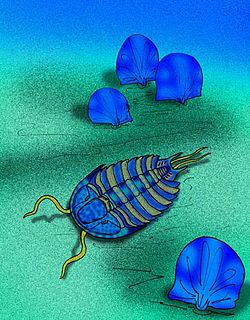
Meteoraspis is an extinct genus of ptychopariid trilobites of the family Tricrepicephalidae. The various species lived from 501 to 490 million years ago during the Dresbachian faunal stage of the late Cambrian Period. Fossils of Meteoraspis are characteristic of Late Cambrian strata in North America, though they are found in Late Cambrian strata elsewhere in the world, such as M. nevensis from Victoria Land, Antarctica.
Fenestraspis is an extinct genus of trilobite in the order Phacopida from the Upper Pragian and Lower Emsian. Fenestraspis is unusual because of the development of extensive fenestrae in the posterior part of the body and apparently of the thorax, the presence of upwardly directed spines on the cephalon, thorax and pygidium, and the exceptionally large and highly elevated eyes.
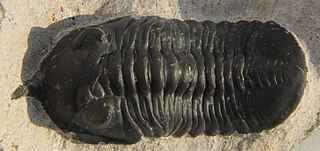
Morocconites malladoides is an average size trilobite, which lived during the Devonian period, in what is now southern Morocco. This species is assumed to be a close relative of Acastoides. The most conspicuous feature is the very long upcurved frontal medial spine, a bit like an avocet bill. It is the only known species in this genus.
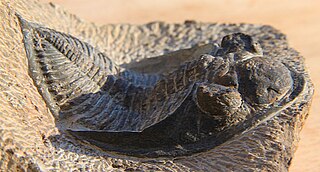
Odontochile is a genus of trilobites in the order Phacopida, family Dalmanitidae.

Eodiscina is trilobite suborder. The Eodiscina first developed near the end of the Lower Cambrian period and became extinct at the end of the Middle Cambrian. Species are tiny to small, and have a thorax of two or three segments. Eodiscina includes six families classified under one superfamily, Eodiscoidea.
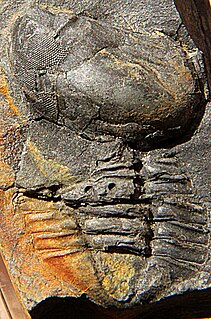
Pricyclopyge is a genus of trilobites assigned to the family Cyclopygidae that occurs throughout the Ordovician. Pricyclopyge had an extratropical distribution, and there is evidence that it lived in darker parts of the water column. Pricyclopyge has huge eyes, an inverted pear-shaped glabella, six thorax segments, with on the 3rd two small discs. Pricyclopyge is known from what are today China, the Czech Republic, France, and the United Kingdom.
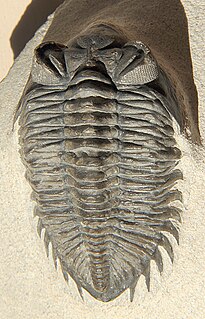
Coltraneia is a genus of trilobite, that lived during the upper Emsian and lower Eifelian, and has been found in Algeria, France, Germany, Morocco and Spain.

Minicryphaeus is a genus of trilobite, that lived during the Pragian in what is today Morocco (Anti-Atlas).

Psychopyge is a genus of trilobite, that lived during the upper Emsian and has been found in Germany and Morocco. It is characterized by the swordlike extension from the front of the head.

Placoparia is a genus of trilobites of average size that lived during the late Lower to the early Upper Ordovician on the paleocontinents Gondwana, Avalonia and Laurentia, now the Czech Republic, France, Germany, Morocco, Portugal, Spain and Wales. Its headshield is semi-circular to rectangular with rounded frontal corners. It lacks eyes, but eye ridges are present. The fact that the facial sutures are opisthoparian is an exception in the otherwise proparian Cheirurina. The thorax has 11 or 12 segments, with the axis slightly wider than the ribs to its sides. The tips of the pleurae are free, which resembles an old-fashion central heating radiator. The axis in the small tailshield consists of four rings and a minute endpiece. The four pleurae end in spatulate spines that fit to corresponding indentations in the cephalon.

Tricrepicephalus is an extinct genus of ptychopariid trilobites of the family Tricrepicephalidae with species of average size. Its species lived from 501 to 490 million years ago during the Dresbachian faunal stage of the late Cambrian Period. Fossils of Tricrepicephalus are widespread in Late Cambrian deposits in North America, but is also known from one location in South-America. Tricrepicephalus has an inverted egg-shaped exoskeleton, with three characteristic pits in the fold that parallels the margin of the headshield just in front of the central raised area. The articulating middle part of the body has 12 segments and the tailshield carries two long, tubular, curved pygidial spines that are reminiscent of earwig's pincers that rise backwards from the plain of the body at approximately 30°.

Viaphacops is a genus of trilobites in the order Phacopida, family Phacopidae, that lived during the Middle Devonian, and is known from North and South America, Asia.






















